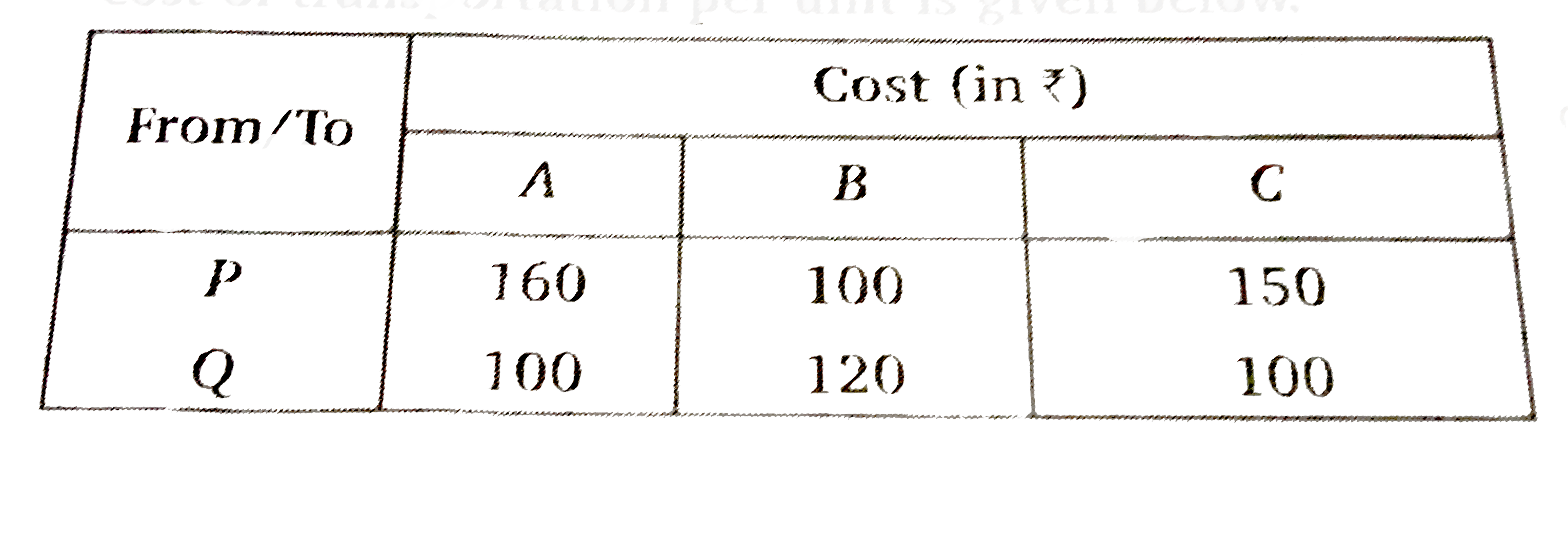A firm produces three products P1P2 and P3 requiring the mix-up of three materials M1,M2 and M3 per unit requirement of each product for each material (in units) is represented by matrix A as follows:

The per unit cost of material M1,M2 and M3 is 5, 10 and 15 respectively.
If C represents the matrix showing cost of material, the matrix C will be expressed as :
C=⎡⎢⎣1055⎤⎥⎦
C[51015]
C=[(5),
C=⎡⎢⎣151020⎤⎥⎦
The correct Answer is:C
Topper's Solved these Questions
Similar Questions
A firm produces 3 products X,YandZ requiring minimum of three materials A,BandC. The per unit requirement of material are given below. Using matrix notation determine (a) Production of each product if firm has 2900,1100and1450 units of each material respectively. (b) Total requirement of each material if the firm produces 200,300and100 units of the three products respectively.
View SolutionOn shirt requires 234m of cloth. How much material is required to make 2 dozen shirts?
View Solution
Knowledge Check
- Question 1 - Select One
If the magnetic dipole moment of an atom of diamagnetic material paramagnetic material and ferromagnetic material are denoted by md,mpandmf respectively then
Amd=0andmp±0Bmd≠andmp=0Cmp=0andmf≠0Dmd≠andmf≠0
Preeti selects a dress material costing Rs. 3512 per metre. She needs 5 m of the material. How much does she have to pay?
View SolutionA firm manufactures two types of products, A and B, and sells them at a profit of Rs.5 per unit of type A and Rs.3 per unit of type B.Each product is processed on two machines, M1andM2. One unit of type A requires one minute of processing time on M1 and one minute on M2. Machines M1andM2. are respectively available for at most 5 hours and 6 hours in a day. Find out how many units of each type of product the fiem should produce a day in order to maximize the profit. Solve the problem graphically.
View SolutionA firm manufactures two products, each of which must be processed through two departments, 1 and 2. The hourly requirements per unit for each product in each department, the weekly capacities in each department, selling price per unit, labour cost per unit, and raw mater cost per unit are summarized as follows: , Product A, Product B, Weekly capacity Department 1 Department 2 Selling price per unit Labour cost per unit Raw material cost per unit, 3 4 Rs. 25 Rs. 16 Rs. 4, 2 6 Rs. 30 Rs. 20 Rs. 4, 130 260 The problem is to determine the number of units to produce each product so as to maximize total contribution to profit. Formulate this as a LPP.
View SolutionA firm manufactures two types of products, A and B, and sells them at a profil of 3 per unit to type B product and 5 perunit of type A product. Both product is processed on two machines M1and M2 One unit of type A requires one minute of processing time on M1 and two minutes of processing time on M2i whereas one unit of type B requires one minute of processing time on M1 and one minute on M Machines sells them at a profit of 5 per unit of type A and M, and M, are respectively available for at most 5 hours and 6 hours in a day. Find out how many units of each type of product the firn should produce a day in order to maximize the profit. Solve the problem graphically [CHSE 2000]
View SolutionA firm manufactures two types of products, A and B, and sells them at a profil of 3 per unit to type B product and 5 perunit of type A product. Both product is processed on two machines M1and M2 One unit of type A requires one minute of processing time on M1 and two minutes of processing time on M2i whereas one unit of type B requires one minute of processing time on M1 and one minute on M Machines sells them at a profit of 5 per unit of type A and M, and M, are respectively available for at most 5 hours and 6 hours in a day. Find out how many units of each type of product the firn should produce a day in order to maximize the profit. Solve the problem graphically [CHSE 2000]
View SolutionThere are factories located one at place P and other at place Q from which a certin commodity is to be delivered to each of three depot situated at A,B and C. The weekly requirement of the depots are respectively 5,5 and 4 units of the commodity while the production capacity of the factories P and Q are respectively 8 and 6 units. The cost of transportation per unit is given below.

How many units should be transported from each factory to each depot in order that the transportation cost is minimum. Also find the minimum transportation cost.View SolutionThere are two factories located one at place P and the other at place Q.From these locations, a certain commodity is to be delivered to each of the three depots situated at A, B and C. The weekly requirments of the depots are respectively 5,5 and 4 units of the commodity while the production capacity of the factories at P and Q are respectively 8 and 6 units. The cost of transportation per unit is given below:

How many units should be transported from each factory to each depot in order that the transportable cost is minimum? When will be the minimum transportation cost?View Solution

